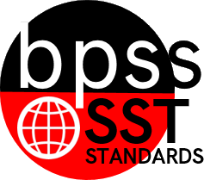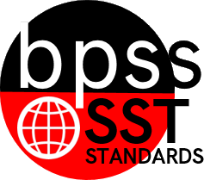Kindergarten Social Studies (Archived)
 BPS District Social Studies Standards Book
BPS District Social Studies Standards Book
SST-00 "I can ... statements"
1st Grade Social Studies
2nd Grade Social Studies
4th Grade Social Studies
5th Grade Social Studies
7th Grade Social Studies
8th Grade Social Studies
S |
|---|
SST-00.1.01Kindergarten (SST) Social Studies Targeted BenchmarksStandard 1: Skills and Resources SST-00.2.01 Identify symbols of the United States (e.g., the flag, bald eagle, Statue of Liberty, patriotic songs, Pledge of Allegiance).Student Learning Targets:Knowledge Targets
Reasoning Targets
Skills (Performance) Targets
Product Targets
Proficiency ScaleThe Student is ...(1) Beginning
(2) Developing
(3) Proficient
(4) Advanced
ResourcesVocabulary
| |
SST-00.2
Narrative for the Important Historical EventsThe goal of social studies education is for children to develop thinking and decision-making skills that prepare them for responsible citizenship in a democratic society. Children begin to acquire these skills at the kindergarten level through learning experiences that allow them to explore their relationships with the immediate environment. Children in kindergarten have the opportunity to use a variety of resources, including technology and electronic and print media, as a means of gathering, organizing, analyzing information, and answering questions. Students should have the opportunity to learn through peer interaction and participation in large and small groups, as well as through individual learning activities. The History standard helps students examine the connections of their own environment with the past, begin to distinguish between symbols, events and people of the past and the present, and use a sense of time in classroom planning and participation. Calculation Method for StandardsStandards are larger groups of related benchmarks. The Standard Grade is a calculation of all the related benchmarks. Click on the benchmark name below each Standard to access the learning targets and proficiency rubrics for each standard's related benchmarks. | |
SST-00.2.01Kindergarten (SST) Social Studies Targeted BenchmarksStandard : History SST-00.2.01 Identify symbols of the United States (e.g., the flag, bald eagle, Statue of Liberty, patriotic songs, Pledge of Allegiance).Student Learning Targets:Knowledge Targets
Reasoning Targets
Skills (Performance) Targets
Product Targets
Proficiency ScaleThe Student is ...(1) Beginning
(2) Developing
(3) Proficient
(4) Advanced
ResourcesVocabulary
| |
SST-00.2.02
Student Learning Targets:Knowledge Targets
Reasoning Targets
Skills (Performance) Targets
Product Targets
Proficiency Scale
ResourcesWebsites Vocabulary | ||||||||||||||||||||||||||||||||||||||||||||
SST-00.2.03
Student Learning Targets:Knowledge Targets
Reasoning Targets
Skills (Performance) Targets
Product Targets
Proficiency Scale
ResourcesWebsites Vocabulary | ||||||||||||||||||||||||||||||||||||||||||||
SST-00.3
Narrative for the Economic ConceptsThe goal of social studies education is for children to develop thinking and decision-making skills that prepare them for responsible citizenship in a society. Children begin to acquire these skills at the kindergarten level through learning experiences that allow them to explore their relationships with the immediate environment. Children are given opportunities to discover how people are similar and different and how people live and work together in families around the world. Kindergarten students should begin to accept responsibility for their behavior in school and to explain why rules are needed in families and at school. Children in kindergarten have the opportunity to use a variety of resources, including technology and electronic and print media, as a means of gathering, organizing, analyzing information, and answering questions. Students should have the opportunity to learn through peer interaction and participation in large and small groups, as well as through individual learning activities. The Economics standard helps students explain that people do different jobs and work to meet basic economic wants and needs. Calculation Method for StandardsStandards are larger groups of related benchmarks. The Standard Grade is a calculation of all the related benchmarks. Click on the benchmark name below each Standard to access the learning targets and proficiency rubrics for each standard's related benchmarks. | |
SST-00.3.01
Student Learning Targets:Knowledge Targets
Proficiency Rubric
ResourcesWebsites Helping Your Child With Social Studies Social Studies in Kindergarten Vocabulary
| ||||||||||||||||||||||||||||||||||||||||
SST-00.4
Narrative for the Government and CitizenshipThe goal of social studies education is for children to develop thinking and decision-making skills that prepare them for responsible citizenship in society. Children begin to acquire these skills at the kindergarten level through learning experiences that allow them to explore their relationships with the immediate environment. Children in kindergarten have the opportunity to use a variety of resources, including technology and electronic and print media, as a means of gathering, organizing, analyzing information, and answering questions. Students should have the opportunity to learn through peer interaction and participation in large and small groups, as well as through individual learning activities. In the Goverment and Citizenship standard students learn that they are citizens of their school, community and the United States; and understand the importance of being a responsible citizen who knows why rules are needed and follows them. Calculation Method for StandardsStandards are larger groups of related benchmarks. The Standard Grade is a calculation of all the related benchmarks. Click on the benchmark name below each Standard to access the learning targets and proficiency rubrics for each standard's related benchmarks. | |
SST-00.4.01
Student Learning Targets:Knowledge Targets
Reasoning Targets
Skills (Performance) Targets
Product Targets
Proficiency Scale
ResourcesWebsites Vocabulary | ||||||||||||||||||||||||||||||||||||||||||||


 Standard 1:
Standard 1: